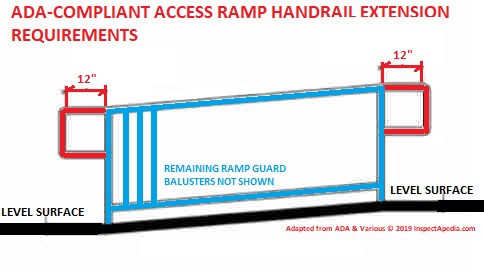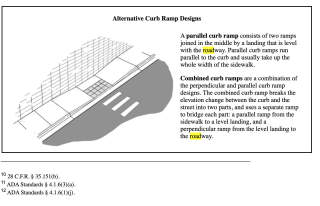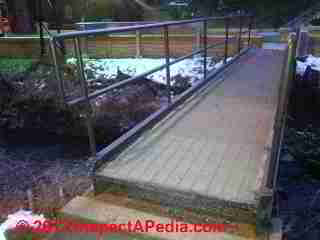 Building Access Ramp Codes & Standards
Building Access Ramp Codes & Standards
- POST a QUESTION or COMMENT about building access ramp construction codes, specifications, hazards, & safety improvements
Building access ramp specifications & codes:
This document provides building code specifications addressing ramp construction, ramp safety and proper ramp railing and guardrail construction.
InspectAPedia tolerates no conflicts of interest. We have no relationship with advertisers, products, or services discussed at this website.
- Daniel Friedman, Publisher/Editor/Author - See WHO ARE WE?
Building Access Ramp Standards and Codes
- ADA (Americans with Disabilities Act), Public Law 101-336. 7/26/90 is very often cited by other sources for good design of stairs and ramps etc. even where disabled individuals are not the design target.
- APPENDIX A to Part 1191 - Americans with Disabilities Act ADA ACCESSIBILITY GUIDELINES FOR BUILDINGS AND FACILITIES, [PDF] Americans with Disabilities Act (ADA) Accessibility Guidelines for Buildings and Facilities, U.S. Architectural and Transportation Barriers Compliance Board (Access Board) 1331 F Street, N.W., Suite 1000 Washington, D.C. 20004-1111 (202) 272-0080 202) 272-0082 TTY (202) 272-0081 FAX
This is the fulltext document. We compressed the file, with no data loss, so that it can be loaded more-quickly into your computer or smartphone. - ANSI A117.4 Accessible and Usable buildings and Facilities (earlier version was incorporated into the ADA)
- ASTM F 1637, Standard Practice for Safe Walking Surfaces, (Similar to the above standards)
- Access Ramp building codes:
- ADA 4.8.2 - see APPENDIX A [PDF] for the ADA live link given above
- BOCA 1016.3 (2009) Excerpt:
1016.3 Maximum slope: The maximum slope of means of egress ramps in the direction of travel shall be one unit vertical in 12 units horizontal (1:12). The maximum slope across the direction of travel shall be one unit vertical in 48 units horizontal (1:48). - IBC 1010.2
- UBC 1003.3.4.3
- BUILDING CODES for STAIRS model codes for Canada, U.S.
- Bukowski, Richard W., EMERGENCY EGRESS FROM BUILDINGS [PDF] NIST Technical Note 1623 Part 1: History and Current Regulations for Egress System Design Part 2: New Thinking on Egress From Buildings, NIST,
Requirements for Guardrailings & Handrailings at Access Ramps

Add railings on your ramp: if the ramp crosses above a ditch, ravine, or is more than three feet from the ground at its highest point, a railing is likely to be required by local and national building codes.
[Click to enlarge any image]
Even for ramps that are just a few inches above the ground, railings improve ramp safety by providing additional visual clues about the ramp's slope as well as providing a grasping surface in case of a fall.
Our photo (left) shows the author's daughter (at left, ca. 1979) with a friend, demonstrating that this building access ramp was unsafe: a railing was provided only on one side despite the drop off
and the railing that the carpenters installed was both open (a child hazard), and used a horizontal mid-height member, easily climbed-on by a child (another child hazard).
Also see GUARDRAIL CODES & STANDARDS
and see HANDRAILS & HANDRAILINGS.
A Comparison of Building Codes Specifying Hand Railing Requirements for Access Ramps
Railings in stair codes and specifications refer to the safety barrier along ramps as well as at steps or stairs, landings, and balconies.
Sample excerpts of sources which a building code compliance inspector would be expected to cite in support of requiring a properly-designed, properly-secured guard rail include but are not limited to the citations below.
The ramp handrail extensions shown in this sketch are discussed in more detail at
HANDRAIL EXTENSION REQUIREMENTS
International Building Code 2000 (BOCA, ICBO, SBCCI)
1003.3.3.11.3 Handrail grasp ability. Handrails with a circular cross section shall have an outside diameter of at least 1.25 inches (32 mm) and not greater than 2 inches (51 mm) or shall provide equivalent grasp ability.
If the handrail is not circular, it shall have a perimeter dimension of at least 4 inches (102 mm) and not greater than 6.25 inches (159 mm) with a maximum cross-section dimension of 2.25 inches (57 mm).
Edges [of th handrailing] shall have a minimum radius of 0.125 inch (3.2 mm).
100333.11.4 Continuity. Handrail-gripping surfaces shall be continuous, without interruption by newel posts or other obstructions.
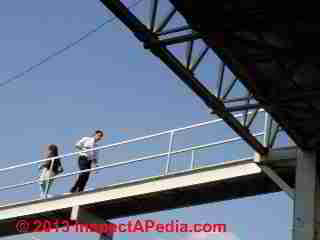
Our photo illustrates a high ramp crossing over a busy highway in Guadalajara, Mexico. The guardrail is continuous, probably has adequate strength, but lacks child-safe enclosing balusters.
1607.7 Loads on Handrails, guards, grab bars and vehicle barriers
1607.7.1.1 Concentrated Load. Handrail assemblies and guards shall be able to resist a single concentrated load of 200 pounds (0.89kN), applied in any direction at any point along the top, and have attachment devices and supporting structure to transfer this loading to appropriate structural elements of the building.
1607.7.1.2 Components. Intermediate rails (all those except the handrail), balusters and panel fillers shall be designed to withstand a horizontally applied normal load of 50 pounds (0.22 kN) on an area not to exceed one square foot (305mm2) including openings and space between rails.
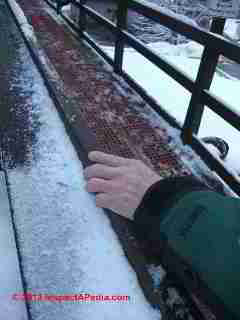
Is this access ramp handrailing (photo at left) actually graspable? Not very. All of the model building codes contain descriptions of graspable and non-graspable handrailings by dimension, shape, profile, support, obstructions and other parameters.
Details are at GRASPABILITY of HANDRAILINGS.
BOCA National Property Maintenance Code 1993:
PM-305.5 Stairs and railings: all interior stairs and railings shall be maintained in sound condition and good repair.
Commentary: Handrails, treads and risers must be structurally sound, firmly attached to the structure, and properly maintained to perform their intended function safely.
During an inspection the code official should inspect all stringers, risers, treads, and handrails.
PM-305.6 Handrails and guards: Every handrail and guard shall be firmly fastened and capable of supporting normally imposed loads and shall be maintained in good condition.
Commentary: This section provides for the safety and maintenance of handrails and guards. See Section PM-702.9 for additional requirements.
PM-702.9 Stairways, handrails and guards: Every exterior and interior flight of stairs having more than four risers, and every open portion of a stair, landing or balcony which is more than 30 inches (762mm) high, nor more than 42 inches (1067mm) high, measured vertically above the nosing of the tread or above the finished floor of the landing or walking surfaces.
Guards shall be not less than 30 inches (762mm) high above the floor of the landing or balcony.
Commentary: Handrails are required on all stairs more than four risers in height. Handrails cannot be less than 30 inches nor more than 42 inches above the nosing of the treads (see Figure PM-702.9).
Guards are required on the open side of stairs and on landings and balconies which are more than 30 inches above the floor or grade below. The guard must be at least 30 inches above the floor of the landing or balcony.
Guards are to contain intermediate rails, balusters or other construction to reduce the chance of an adult or child from falling through the guard.
If the guard is missing some intermediate rails or balustrades, it is recommended that the guard be repaired to its original condition if it will provide protection equivalent to the protection it provided when originally constructed.
Florida Handrail & Guardrail Requirements & Codes for Access Ramps
Handrails shall be provided along both sides of a ramp run with a rise greater than 6 inches (152 mm) and shall conform to the requirements in Sections 1012.
If handrails are not continuous, they shall extend at least 18 inches (305 mm) beyond the top and bottom of the ramp segment and shall be parallel with the floor or ground surface.
Ends of handrails shall be either rounded or returned smoothly to floor, wall or post. Handrails shall not rotate within their fittings.
Top of the handrail gripping surface shall be not less than 34 inches (864 mm) nor more than 38 inches (965 mm) above the ramp surface. - Florida Building Code 1010.8 Handrails
Exceptions:
1. Handrails are not required when the total ramp run rise is 6 inches (152 mm) or less and the horizontal projection is 72 inches or less, except where required to be accessible.
2. Aisles in Group A occupancies (see Section 1025).
3. NA
4. Handrails are not required on curb ramps. - Florida Building Code 1010.8 Handrails
Guards shall be provided where required by Section 1013 and shall be constructed in accordance with Section 1013. - Florida Building Code 1010.10 Guards
505.10.1 Top and Bottom Extension at Ramps. Ramp handrails shall extend horizontally above the landing for 12 inches (305 mm) minimum beyond the top and bottom of ramp runs.
Extensions shall return to a wall, guard, or the landing surface, or shall be continuous to the handrail of an adjacent ramp run. - Florida Building Code 505.10.1
Also see SNAG HAZARDS on STAIRWAYS
Requirements & Building Code Citations for Landing Platforms at Access Ramps
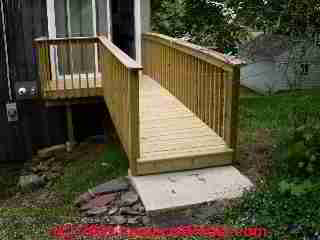
Landing platforms for ramps: Make sure the ramp is properly designed in width, structural support, and that it includes a landing both at the upper end at a building entry/exit door, and where required by local code or ground surface conditions, also provide a landing platform at the ramp's lower end.
As we mentioned at our page to photo, the step at this building access ramp entry reduced the ramp slope to less than 1:12 but it created an obstruction for wheelchair users.
While the landing platform assists the users of this access ramp, what we had specified was that the ramp bottom end terminate at grade, without a step. And this platform is probably too short in the direction of travel.
The "railings" along this ramp are not readily graspable, but as the ramp is nearly level, we considered them as a balcony railing not a handrail.
Ramp Landing requirement: Ramps shall have landings at the bottom and top of each ramp, points of turning, entrance, exits and at doors and in accordance with Section 11-4.8.4. Landings shall comply with Sections 1010.6.1 through 1010.6.5. - Florida Building Code 1010.6 Landings.
Ramp Landing slope: Landings shall have a slope not steeper than one unit vertical in 50 units horizontal (2-percent slope) in any direction. Changes in level are not permitted. - Florida Building Code 1010.6.1 Landings.
Ramp Landing width: The landing shall be at least as wide as the widest ramp run adjoining the landing. - Florida Building Code 1010.6.2 Landings.
Question: what is the meaning of "accessible route of travel" and when is a 1:8 ramp slope acceptable?
(July 20, 2015) Rod Trebelcock said:
Our local code, UBC, 1003.3.4.3 starts with the maximum slope of 1:12 in "an accessible route of travel", other ramps can be 1:8. Can you give the meaning of " an accessible route of travel? And how is " other ramps " acceptable at 1:8. I am short on room.
Reply: definition of accessible route of travel and of acceptable ramp slopes
Rod
Thanks for your helpful question about the definition of an "accessible route of travel".
My understanding is contextual. In ADA and similar standards, the writers mean, by "accessible route of travel", a route or passage that is intended to be ADA compliant for use by wheelchairs.
Here is a quote from the actual ADA definition from the ADAAG
Accessible Route.
A continuous unobstructed path connecting all accessible elements and spaces of a building or facility. Interior accessible routes may include corridors, floors, ramps, elevators, lifts, and clear floor space at fixtures.
Exterior accessible routes may include parking access aisles, curb ramps, crosswalks at vehicular ways, walks, ramps, and lifts.
Watch out: In the UBC where the slopes you ask about are discussed, a wheelchair ramp pitched at a 1:8 slope (1" of rise in every 8" of horizontal run) is the maximum slope allowed (be careful in reading websites as some sites don't understand slope and call this the minimum but in my lexicon the steepest slope would be the maximum or steepest slope allowed) - this isn't a recommended slope.
The recommended maximum slope for a wheelchair ramp is 1 inch of rise in 12 inches of run. That is less steep and thus easier to negotiate.
Where you are short on space even with a 1:8 slope, and need to comply with the ADA I'd look at a ramp with landings and turns to make the total ascent.
Excerpt from "ADA Accessibility Guidelines (ADAAG)"
4.3 Accessible Route.
4.3.1* General. All walks, halls, corridors, aisles, skywalks, tunnels, and other spaces that are part of an accessible route shall comply with 4.3. Appendix Note
4.3.2 Location.
(1) At least one accessible route within the boundary of the site shall be provided from public transportation stops, accessible parking, and accessible passenger loading zones, and public streets or sidewalks to the accessible building entrance they serve. The accessible route shall, to the maximum extent feasible, coincide with the route for the general public.
(2) At least one accessible route shall connect accessible buildings, facilities, elements, and spaces that are on the same site.
(3) At least one accessible route shall connect accessible building or facility entrances with all accessible spaces and elements and with all accessible dwelling units within the building or facility.
(4) An accessible route shall connect at least one accessible entrance of each accessible dwelling unit with those exterior and interior spaces and facilities that serve the accessible dwelling unit.
4.3.3 Width. The minimum clear width of an accessible route shall be 36 in (915 mm) except at doors (see 4.13.5 and 4.13.6).
If a person in a wheelchair must make a turn around an obstruction, the minimum clear width of the accessible route shall be as shown in Fig. 7(a) and (b).
Below we provide a link to the full text of the ADA. In the Definitions section of that document you'll find helpful definitions of ramp slope and accessible route and other terms.
Americans with Disabilities Act (ADA) Accessibility Guidelines for Buildings and Facilities - Full text PDF
- APPENDIX A to Part 1191 - Americans with Disabilities Act ADA ACCESSIBILITY GUIDELINES FOR BUILDINGS AND FACILITIES, [PDF] Americans with Disabilities Act (ADA) Accessibility Guidelines for Buildings and Facilities, U.S. Architectural and Transportation Barriers
Compliance Board (Access Board), 1331 F Street, N.W., Suite 1000, Washington, D.C. 20004-1111 USA, Tel: (202) 272-0080 (202) 272-0082 TTY (202) 272-0081 FAX
This is the fulltext document. We compressed the file, with no data loss, so that it can be loaded more-quickly into your computer or smartphone.
- IRELAND (Northern Ireland) STAIR GUARD LANDING RAMP CODE [PDF] ret. 2018/11/23, original source: http://www.buildingcontrol-ni.com/assets/pdf/H2006.pdf
...
Reader Comments, Questions & Answers About The Article Above
Below you will find questions and answers previously posted on this page at its page bottom reader comment box.
Reader Q&A - also see RECOMMENDED ARTICLES & FAQs
On 2021-08-20 by inspectapedia.com.moderator (mod) - rules for access ramps that connect to or close to a road or street
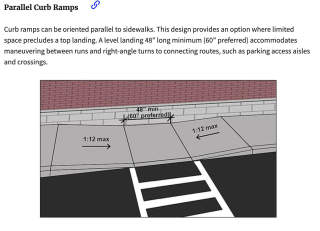 @william hopson,
@william hopson,
We'll describe two different situations: a ramp that is at right angles to a roadway and a ramp that parallels a roadway.
First, in general, an access ramp that is ADA compliant has a 60-inch landing space in the direction of travel at the top and bottom of the ramp.
In addition, a curb cut ramp has at least 36" of landing space at the top of the curb ramp.
(Your local inspector might allow those two to overlap);
A ramp perpendicular to a street, then, needs the landing space + sidewalk width + curb cut spaces.
A different case arises when a ramp is parallel to a street.
In that case there are two designs:
A parallel curb ramp consists of two ramps joined in the middle by a landing that is level with the roadway. Parallel curb ramps run parallel to the curb and usually take up the whole width of the sidewalk.
Combined curb ramps are a combination of the perpendicular and parallel curb ramp designs. The combined curb ramp breaks the elevation change between the curb and the street into two parts, and uses a separate ramp to bridge each part: a parallel ramp from the sidewalk to a level landing, and a perpendicular ramp from the level landing to the roadway.
In addition to the ADA ramp codes given above on this page,
See this
CURB RAMP CROSSINGS ADA GUIDE [PDF]
This illustrates curb ramp alternatives that might affect your design
This illustration shows what happens if there is a curb ramp with returned sides: note the 36" space at ramp top.
On 2021-08-20 by william hopson - how close can I get to the roadway on a ramp?
how close can I get to the roadway on a ramp?
On 2021-05-10 by (mod) - does a walking ramp have different codes than a wheelchair ramp
@Fred Norman,
Codes and standards are the same, all referred to as access ramps.
The premise is that a ramp designed for walkers should also be designed for wheelchair access - at least in public spaces.
On 2021-05-09 by Fred Norman
I wanted to know what applicable codes to a walking ramp? Not wheelchair access
On 2019-03-01 by (mod)
Jack:
To answer your question:
How long can a ramp run before you need a flat landing area ?
Reply:
at RAMP SLOPE or PITCH
I have repeated the question and give a detailed, illustrated reply in the article above.
You may need to clear your browser cache and refersh the page to see the updates.
Please take a look at the 30 ft and 40 ft run explanations there and let me know if you have further questions. Thank you for asking.
On 2018-08-07 by (mod) - what is the rate of rise for a ramp
Access Ramp building codes:
ADA 4.8.2 - see APPENDIX A [PDF] for the ADA live link given above
BOCA 1016.3 (2009) Excerpt:
1016.3 Maximum [ramp] slope:
The maximum slope of means of egress ramps in the direction of travel shall be one unit vertical in 12 units horizontal (1:12).
The maximum slope across the direction of travel shall be one unit vertical in 48 units horizontal (1:48).
IBC 1010.2
UBC 1003.3.4.3
On 2018-08-07 by john
whats the rate of rise for a ramp in a commercial office buildings loading dock? were located in Washington dc
On 2017-05-28 by (mod) - can I use wood for a ramp guardail and handrail?
Dania
Thanks for the good questions.
You can certainly use wood, but be sure that the handrailing is graspable. Use the search box for this site (just above) to find our article on HANDRAIL GRASPABILITY to see details for graspable wood handrails. The guardrail top (which will be higher) doesn't need to be graspable. The minimum handrail height is 34” from the ramp surface and the maximum handrail height is 38”.
On 2017-05-28 by Dania
I have a 12ft ramp inside my business and I need a railing can I use wood or does it have to be a metal bar
...
Continue reading at RAMP LANDING CODES or select a topic from the closely-related articles below, or see the complete ARTICLE INDEX.
Or see these
Recommended Articles
- ACCESSIBLE DESIGN
- ADA STAIR & RAIL SPECIFICATIONS
- BATHROOM DESIGN, ACCESSIBLE
- CUSTOM TOILETS
- DISABLED or ELDERLY-USE TOILETS
- ELDERLY & VETERANS HOME SAFETY
- KITCHEN DESIGN, ACCESSIBLE
- RAMPS, ACCESS - home
- RAMP CODES & STANDARDS
- RAMP LANDING CODES
- RAMP RAILING CODES
- RAMP SLOPE or PITCH
- RAMP SLIP TRIP FALL HAZARDS
- RAMP SLIP TRIP FALL REDUCTION
- STAIR DESIGN for SENIORS
- STAIRWAY CHAIR LIFTS
Suggested citation for this web page
RAMP CODES & STANDARDS at InspectApedia.com - online encyclopedia of building & environmental inspection, testing, diagnosis, repair, & problem prevention advice.
Or see this
INDEX to RELATED ARTICLES: ARTICLE INDEX to STAIRS RAILINGS LANDINGS RAMPS
Or use the SEARCH BOX found below to Ask a Question or Search InspectApedia
Ask a Question or Search InspectApedia
Try the search box just below, or if you prefer, post a question or comment in the Comments box below and we will respond promptly.
Search the InspectApedia website
Note: appearance of your Comment below may be delayed: if your comment contains an image, photograph, web link, or text that looks to the software as if it might be a web link, your posting will appear after it has been approved by a moderator. Apologies for the delay.
Only one image can be added per comment but you can post as many comments, and therefore images, as you like.
You will not receive a notification when a response to your question has been posted.
Please bookmark this page to make it easy for you to check back for our response.
IF above you see "Comment Form is loading comments..." then COMMENT BOX - countable.ca / bawkbox.com IS NOT WORKING.
In any case you are welcome to send an email directly to us at InspectApedia.com at editor@inspectApedia.com
We'll reply to you directly. Please help us help you by noting, in your email, the URL of the InspectApedia page where you wanted to comment.
Citations & References
In addition to any citations in the article above, a full list is available on request.
- Stephenson, Elliott O., THE ELIMINATION OF UNSAFE GUARDRAILS, A PROGRESS REPORT [PDF] Building Standards, March-April 1993
- "Are Functional Handrails Within Our Grasp" Jake Pauls, Building Standards, January-February 1991
- Access Ramp building codes:
- UBC 1003.3.4.3
- BOCA 1016.3
- ADA 4.8.2
- IBC 1010.2
- Access Ramp Standards:
- ADA (Americans with Disabilities Act), Public Law 101-336. 7/26/90 is very often cited by other sources for good design of stairs and ramps etc. even where disabled individuals are not the design target.
- ANSI A117.4 Accessible and Usable buildings and Facilities (earlier version was incorporated into the ADA)
- ASTM F 1637, Standard Practice for Safe Walking Surfaces, (Similar to the above standards)
- Slips, Trips, Missteps and Their Consequences, Second Edition, Gary M. Bakken, H. Harvey Cohen,A. S. Hyde, Jon R. Abele, ISBN-13: 978-1-933264-01-1 or ISBN 10: 1-933264-01-2, available from the publisher, Lawyers & Judges Publishing Company,Inc., www.lawyersandjudges.com sales@lawyersandjudges.com
- The Stairway Manufacturers' Association, (877) 500-5759, provides a pictorial guide to the stair and railing portion of the International Residential Code. [copy on file as http://www.stairways.org/pdf/2006%20Stair%20IRC%20SCREEN.pdf ] -
- The following stair books and other books on stair history, design, and architecture can be purchased at our Amazon-Supported InspectAPedia Bookstore
- Falls and Related Injuries: Slips, Trips, Missteps, and Their Consequences, Lawyers & Judges Publishing, (June 2002), ISBN-10: 0913875430 ISBN-13: 978-0913875438
"Falls in the home and public places are the second leading cause of unintentional injury deaths in the United States, but are overlooked in most literature. This book is unique in that it is entirely devoted to falls. Of use to primary care physicians, nurses, insurance adjusters, architects, writers of building codes, attorneys, or anyone who cares for the elderly, this book will tell you how, why, and when people will likely fall, what most likely will be injured, and how such injuries come about. " - Slips, Trips, Missteps and Their Consequences, Gary M. Bakken, H. Harvey Cohen, Jon R. Abele, Alvin S. Hyde, Cindy A. LaRue, Lawyers and Judges Publishing; 2 edition (April 2006), ISBN-10: 1933264012 ISBN-13: 978-1933264011
- Steps and Stairways, Cleo Baldon & Ib Melchior, Rizzoli, 1989.
- The Staircase, Ann Rinaldi
- Common Sense Stairbuilding and Handrailing, Fred T. Hodgson
- The Art of Staircases, Pilar Chueca
- Building Stairs, by pros for pros, Andy Engel
- A Simplified Guide to Custom Stairbuilding, George R. Christina
- Basic Stairbuilding, Scott Schuttner
- The Staircase (two volumes), John Templar, Cambridge: the MIT Press, 1992
- The Staircase: History and Theories, John Templar, MIT Press 1995
- Steps and Stairways, Cleo Baldon & Ib Melchior, Rizzoli, 1989.
- "The Dimensions of Stairs", J. M. Fitch et al., Scientific American, October 1974
- Our recommended books about building & mechanical systems design, inspection, problem diagnosis, and repair, and about indoor environment and IAQ testing, diagnosis, and cleanup are at the InspectAPedia Bookstore. Also see our Book Reviews - InspectAPedia.
- In addition to citations & references found in this article, see the research citations given at the end of the related articles found at our suggested
CONTINUE READING or RECOMMENDED ARTICLES.
- Carson, Dunlop & Associates Ltd., 120 Carlton Street Suite 407, Toronto ON M5A 4K2. Tel: (416) 964-9415 1-800-268-7070 Email: info@carsondunlop.com. Alan Carson is a past president of ASHI, the American Society of Home Inspectors.
Thanks to Alan Carson and Bob Dunlop, for permission for InspectAPedia to use text excerpts from The HOME REFERENCE BOOK - the Encyclopedia of Homes and to use illustrations from The ILLUSTRATED HOME .
Carson Dunlop Associates provides extensive home inspection education and report writing material. In gratitude we provide links to tsome Carson Dunlop Associates products and services.


